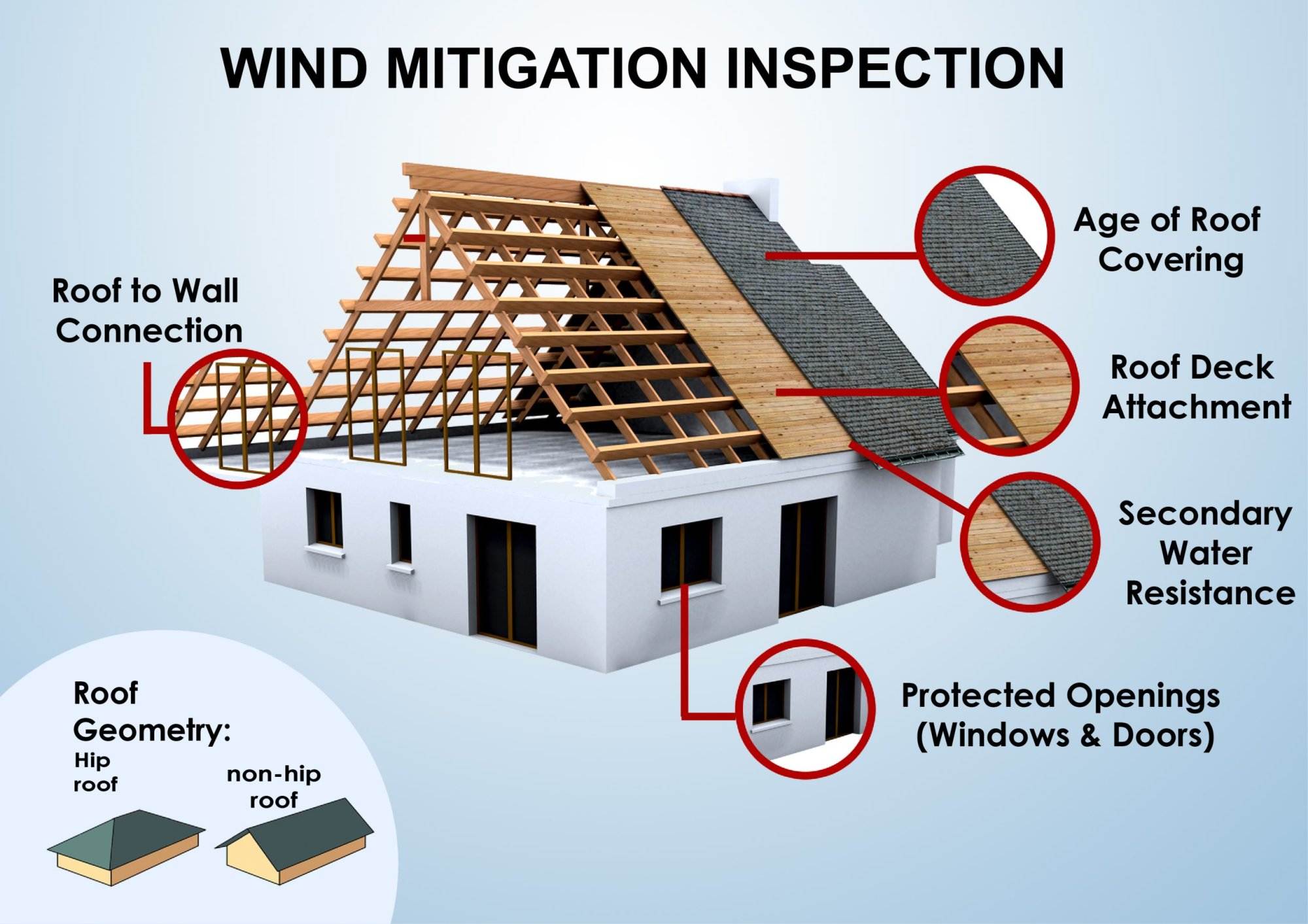Ever wondered how much it would cost to get a wind mitigation inspection done in sunny Florida? Well, we’ve got you covered. In this article, we’ll be shedding some light on the average cost of a wind mitigation inspection in the Sunshine State. So if you’re a homeowner looking to protect your property from the potential damages of strong winds, or perhaps you’re just curious about the financial implications of such an inspection, stick around as we break down the numbers for you.
Factors Affecting the Cost of a Wind Mitigation Inspection
Size and Type of Property
The size and type of the property are major factors that can impact the cost of a wind mitigation inspection. Larger properties typically require more time and effort to inspect, which can result in higher inspection fees. Additionally, different types of properties may have varying levels of risk when it comes to wind damage. For example, a single-family home may have different vulnerabilities compared to a high-rise condominium. The complexity of the property will also influence the cost as it may require additional inspections or specialized expertise.
Location of the Property
The location of the property plays a significant role in determining the cost of a wind mitigation inspection. Wind zones and susceptibility to severe weather events can vary greatly depending on the region. Some areas might have a higher risk of hurricanes or windstorms, leading to a more comprehensive inspection. Furthermore, the building codes and regulations specific to the location can impact the requirements for wind mitigation measures, which may affect the inspection process and ultimately the cost.
Age of the Property
The age of the property is another crucial factor when considering the cost of a wind mitigation inspection. Older properties may have outdated construction methods or materials that could make them more susceptible to wind damage. Inspecting older properties may require additional time and expertise to evaluate their strength and resilience against wind events. As a result, the cost of the inspection may be higher compared to newer properties built to more recent building codes and standards.
Accessibility of the Property
The accessibility of the property can also influence the cost of a wind mitigation inspection. If the property is difficult to access due to factors such as its location, height, or surrounding obstacles, it may require additional time and effort to complete the inspection. This can potentially result in higher inspection fees to account for the added challenges faced by the inspector. Therefore, the ease of access to the property is an important consideration when estimating the cost of a wind mitigation inspection.
Additional Services Requested
Wind mitigation inspections may offer additional services beyond the standard inspection requirements. These additional services can include assessments for additional risk factors such as mold, termites, or structural integrity. If any of these services are requested, it can impact the overall cost of the inspection. The more comprehensive the inspection, the more time and effort required by the inspector, and consequently, the higher the cost. Therefore, clients should consider the additional services they require and how they may affect the overall cost of the wind mitigation inspection.
Typical Range of Costs
When it comes to the cost of a wind mitigation inspection, it is helpful to be aware of the typical range of costs. While the actual price may vary depending on the specific factors discussed earlier, understanding the general pricing structure can provide a starting point for budgeting and decision-making.
Low-End Costs
On the lower end of the cost spectrum, wind mitigation inspections can range from around $75 to $150. These lower-cost inspections might be suitable for smaller properties, such as condos or townhouses, located in areas with relatively low wind risk. However, it is essential to note that the level of detail and thoroughness of the inspection may vary at this price range.
Mid-Range Costs
For mid-range costs, wind mitigation inspections generally fall between $150 and $300. Properties of moderate size and complexity in areas with a moderate risk of wind damage typically fall within this range. These inspections usually offer a more comprehensive evaluation of the property’s wind resistance features, providing a more accurate assessment of potential savings on insurance premiums and improved safety measures.
High-End Costs
High-end wind mitigation inspections can range from $300 to $500 or even higher, depending on the specific circumstances. These inspections are often necessary for larger properties, such as expansive estates or commercial buildings, located in high-risk wind zones. The level of detail and expertise required for these inspections justifies the higher cost. Additionally, high-end inspections may include advanced assessments and recommendations for specialized wind mitigation measures tailored to the property’s unique characteristics.
Keep in mind that these figures are general estimates and can vary depending on various factors. It is best to consult with reputable wind mitigation inspectors and obtain specific quotes to understand the cost accurately.
This image is property of nebula.wsimg.com.
Cost Breakdown of a Wind Mitigation Inspection
Understanding the cost breakdown of a wind mitigation inspection can give an insight into the specific components and factors that contribute to the overall cost. An itemized breakdown helps clients understand where their money is being allocated and provides transparency in the pricing structure. Here are some common components included in a cost breakdown for a wind mitigation inspection:
Inspection Fee
The inspection fee covers the basic cost of the wind mitigation inspection service. It includes the inspector’s time, expertise, and resources required to conduct a comprehensive assessment of the property’s wind resistance features. The inspection fee varies depending on the size, type, and complexity of the property, as well as its location and accessibility.
Roof Inspection
A crucial component of a wind mitigation inspection is the evaluation of the roof’s construction and integrity. This includes assessing the roofing materials, design, age, and condition. The roof inspection typically involves inspecting the roof covering, roof deck attachment, and roof to wall connections. Since the roof is often the most vulnerable area during severe weather events, thoroughly examining its wind resistance measures and potential weaknesses is instrumental in determining the property’s overall resilience.
Exterior Wall Construction
The exterior walls of a property play a significant role in its ability to withstand wind forces. During a wind mitigation inspection, the inspector will assess the construction and materials of the exterior walls, looking for features that increase the wall’s resistance to wind pressure. This can include evaluating the fastening methods, reinforcement, and overall design. The quality and strength of the exterior walls contribute to the overall wind resistance of the property, and their assessment is an important factor in determining potential savings on insurance premiums.
Secondary Water Resistance
Secondary water resistance measures are aimed at preventing water intrusion during severe weather events, such as hurricanes or heavy rainstorms. These measures can include additional waterproofing barriers, such as peel-and-stick membranes or underlayment systems, which provide an extra layer of defense against water penetration. Inspecting the presence and effectiveness of secondary water resistance features is crucial in reducing potential water damage during wind-driven rain events.
Opening Protection
The openings in a property, such as windows, doors, and skylights, can be vulnerable areas for wind infiltration and damage. During a wind mitigation inspection, the inspector will evaluate the type of opening protection installed, such as shutters or impact-resistant glass. These protective features can significantly enhance the property’s resistance to wind forces and reduce the likelihood of severe damage. Assessing the quality and effectiveness of the opening protection helps determine the property’s overall wind resistance and potential insurance savings.
Roof Deck Attachment
The roof deck, also known as the roof sheathing, is an essential component in the integrity and overall strength of the roof system. Properly attached and secured roof decks minimize the risk of wind uplift and structural failure during severe weather events. The wind mitigation inspector will examine the roof deck attachment, checking for suitable fastening methods and stability. This assessment is crucial in determining the property’s overall wind resistance and ensuring the roof remains securely in place during wind events.
Roof to Wall Connections
The connection between the roof and the walls is another critical area of focus during a wind mitigation inspection. Strong and secure roof to wall connections are crucial in preventing roof uplift and reducing the risk of structural failure. The inspector will assess the type of roof to wall connections, such as hurricane straps or clips, and evaluate their strength and effectiveness. A well-secured roof to wall connection significantly enhances the property’s wind resistance and can influence potential savings on insurance premiums.
Hurricane Shutters
Hurricane shutters are an effective form of opening protection that can be deployed over windows and doors during severe weather events. These shutters provide an additional layer of defense against winds and wind-driven debris. The inspector will evaluate the presence, type, and quality of hurricane shutters during the wind mitigation inspection. The inclusion of hurricane shutters enhances the property’s protection against wind pressure and can contribute to potential insurance savings.
Impact-Resistant Glass
Impact-resistant glass, also known as hurricane or wind-resistant glass, is designed to withstand high winds and resist penetration from windborne debris. It is a valuable feature for properties located in areas prone to hurricanes or severe windstorms. During a wind mitigation inspection, the inspector will assess the presence and quality of impact-resistant glass. This evaluation is crucial in determining the property’s resistance to wind infiltration and potential savings on insurance premiums.
Additional Services
Depending on the specific needs and requirements of the client, additional services may be requested as part of the wind mitigation inspection. These could include assessments for mold, termites, radon, or other potential risk factors. The cost of additional services will depend on the type and extent of the additional inspections required. Clients should communicate their specific needs to the inspector beforehand to obtain accurate pricing information for any additional services.
Bear in mind that the cost breakdown may vary among different wind mitigation inspectors. It is essential to discuss the specific cost breakdown with prospective inspectors to ensure a thorough understanding of the services provided and corresponding pricing structure.
Factors to Consider When Choosing a Wind Mitigation Inspector
Selecting a skilled and experienced wind mitigation inspector is crucial to obtaining an accurate assessment of a property’s wind resistance features. There are several factors to consider when choosing a wind mitigation inspector, including:
Certification and Experience
One of the most important factors to consider is the inspector’s certification and experience. Look for inspectors who are certified by reputable organizations, such as the Florida Division of Emergency Management or the My Safe Florida Home Program. Certification provides assurance that the inspector has received proper training and has demonstrated proficiency in conducting wind mitigation inspections. Additionally, consider the inspector’s experience in the industry and the number of inspections they have performed. An experienced wind mitigation inspector is likely to have a solid understanding of the local building codes and requirements.
Reputation and References
It is always beneficial to consider the reputation of a wind mitigation inspector. Look for inspectors who have positive reviews and feedback from previous clients. Request references and contact them to inquire about their experience with the inspector. Reliable and reputable inspectors will have a track record of providing thorough and accurate wind mitigation inspections. Online resources and review platforms can also provide insights into the inspector’s reputation and credibility.
Insurance Coverage
Ensure that the wind mitigation inspector has liability insurance coverage. Liability insurance protects both the inspector and the client in case of any damages or errors that may occur during the inspection. Inspectors who are properly insured demonstrate a commitment to professionalism and accountability.
Scheduling and Availability
Consider the scheduling and availability of the wind mitigation inspector. Determine if they can accommodate your preferred inspection date and time. It is advisable to engage an inspector who can offer reasonable scheduling options and flexibility. A prompt response and efficient scheduling indicate professionalism and responsiveness, which are desirable qualities in a wind mitigation inspector.
Turnaround Time for Report
Inquire about the turnaround time for receiving the wind mitigation report. Some inspectors may provide the report immediately after the inspection, while others may take a few days to deliver. Consider your specific needs and requirements in terms of report delivery and select an inspector who can provide the report within a timeframe that suits your needs. However, prioritize accuracy and thoroughness over speed, as the quality of the report is of utmost importance.
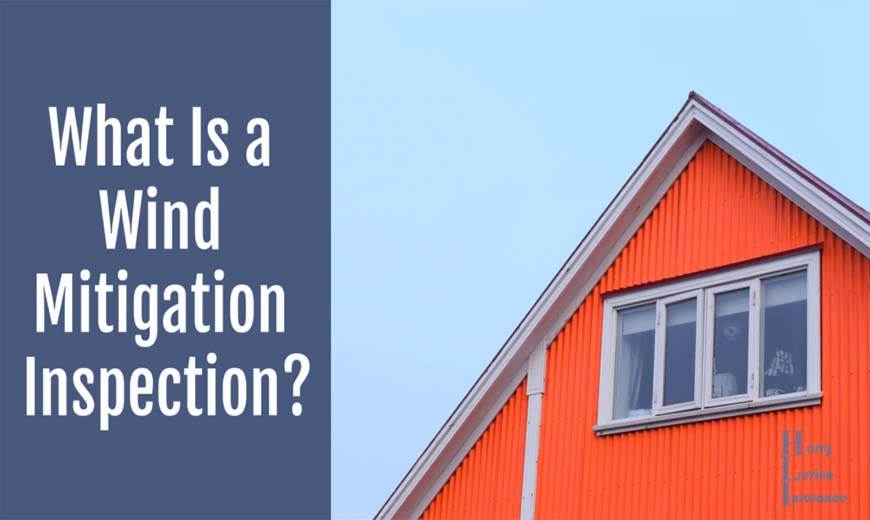
This image is property of www.harrylevineinsurance.com.
Ways to Save on the Cost of a Wind Mitigation Inspection
While wind mitigation inspections are important for reducing insurance premiums and strengthening home safety, it is natural to seek ways to minimize the associated costs. Here are some strategies that can help save on the cost of a wind mitigation inspection:
Shop Around for Different Quotes
Obtain quotes from multiple wind mitigation inspectors. Compare the pricing, services offered, and level of experience to identify the most suitable option for your needs. Keep in mind that the cheapest option may not always be the best choice. Consider the inspector’s qualifications and reputation in addition to the cost to ensure a quality inspection. By shopping around, you can find a balance between affordability and expertise.
Bundle Services
Consider bundling the wind mitigation inspection with other inspections or services. Many homeowners hire inspectors for various assessments, such as termite inspections, mold inspections, or general home inspections. Inquiring about package deals or discounts for bundling services can lead to overall cost savings. Additionally, bundling services can streamline the inspection process and save both time and effort.
Consider Group or Neighborhood Inspections
Organizing a group or neighborhood inspection can be a cost-effective option. By coordinating with neighbors or other property owners in your vicinity, you can potentially negotiate a lower rate for multiple inspections. The inspector may offer discounted rates for conducting multiple inspections in close proximity, as it reduces travel time and costs for them. Group inspections can be a win-win situation, benefiting both the inspector and the property owners.
Take Advantage of Discounts
Inquire about any available discounts that may be applicable. Some wind mitigation inspectors offer discounts for specific situations, such as military personnel, seniors, or repeat customers. Discussing potential discounts with the inspector can lead to cost savings without compromising the quality of the inspection. It is worth exploring all possible avenues for discounts to ensure the best value for your money.
Combine with Other Inspections
If you are already planning to conduct other inspections, such as a home inspection or a termite inspection, consider combining them with the wind mitigation inspection. This approach can potentially result in cost savings, as the inspector may offer a discounted rate for multiple inspections. By bundling inspections, you can streamline the process and cover all necessary assessments in one go, reducing time and expenses.
Remember to prioritize the quality and thoroughness of the wind mitigation inspection when seeking cost-saving strategies. Cutting corners or sacrificing expertise for a lower cost may compromise the accuracy and reliability of the inspection, potentially leading to inadequate mitigation measures and missed opportunities for insurance savings.
Importance of a Wind Mitigation Inspection
A wind mitigation inspection carries several significant benefits for homeowners, extending beyond the immediate assessment of a property’s wind resistance features. Understanding the importance of a wind mitigation inspection can help homeowners appreciate the value it brings to their property and insurance coverage.
Reducing Insurance Premiums
One of the primary benefits of a wind mitigation inspection is the potential for significant savings on homeowners insurance premiums. By identifying and documenting the wind-resistant features of a property, homeowners can leverage this information to negotiate lower insurance rates. Insurance companies often offer discounts or premium reductions for properties with verified wind mitigation measures in place. A comprehensive and accurate wind mitigation inspection report can serve as evidence of the property’s resilience and contribute to substantial cost savings over time.
Increasing Home Safety
Apart from cost savings, a wind mitigation inspection focuses on assessing the strength and integrity of a property’s construction and features. By identifying areas of vulnerability and recommending necessary improvements, homeowners can enhance their property’s safety during severe weather events. Implementing the recommended wind mitigation measures can minimize the risk of wind damage, protect occupants, and reduce the potential for property loss. A wind mitigation inspection promotes proactive actions to fortify homes and safeguard residents.
Strengthening Home Resale Value
Investing in wind mitigation measures and obtaining a comprehensive wind mitigation inspection report can positively impact a property’s resale value. Prospective buyers often consider the wind resistance features of a property when making purchasing decisions, especially in areas prone to windstorms or hurricanes. A property with documented wind mitigation measures in place and an up-to-date inspection report carries greater value in the marketplace. It demonstrates the owner’s commitment to fortified construction and provides assurance to potential buyers regarding the property’s resilience against wind events.
Complying with Insurance Requirements
Depending on the region and insurance company, wind mitigation inspections may be mandatory for obtaining certain insurance coverage or complying with insurer requirements. Many insurance companies in wind-prone areas require wind mitigation inspections as part of the application process. Complying with these requirements ensures that the property meets the insurer’s standards and can help homeowners secure suitable insurance coverage. By obtaining a wind mitigation inspection, homeowners can fulfill insurance obligations and facilitate a more streamlined insurance application process.
Considering the potential cost savings, improved safety, enhanced resale value, and compliance with insurance requirements, it is evident that a wind mitigation inspection is a valuable investment for homeowners. Beyond the immediate benefits, it provides long-term peace of mind and financial advantages.
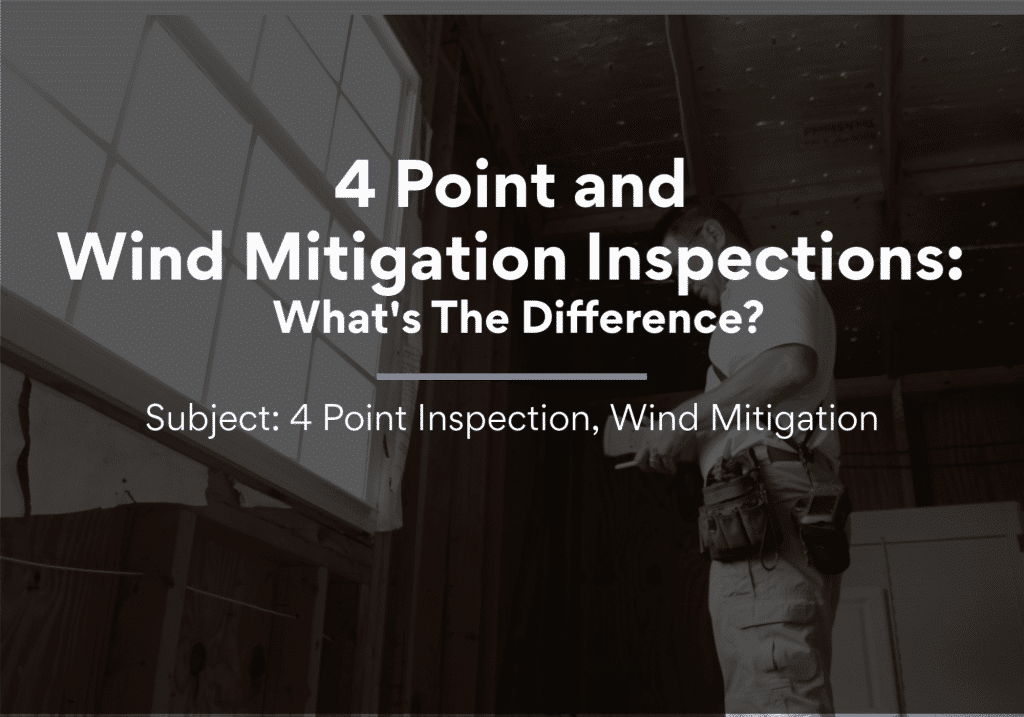
This image is property of edcprofessionalhomeinspections.com.
Comparison of Wind Mitigation Inspection Costs to Potential Savings
One significant consideration for homeowners in deciding whether to pursue a wind mitigation inspection is the potential savings that can be achieved. While wind mitigation inspections incur a cost, the potential cost savings on homeowners insurance premiums can often outweigh the initial investment. A careful comparison of wind mitigation inspection costs to potential savings can provide insight into the return on investment.
Calculating Potential Savings
To calculate potential savings, homeowners should consult their insurance agent or carrier. Insurance companies typically offer discounts or credits for verified wind mitigation measures in place. The exact percentage of savings may vary depending on factors such as the location, wind zone, construction features, and the insurer’s specific guidelines. Homeowners should inquire about the available discounts and the requirements for eligibility.
Once homeowners have obtained the necessary information from their insurer, they can estimate potential savings by comparing the cost of the wind mitigation inspection to the annual premium reduction. For example, if a wind mitigation inspection costs $250 and results in a 10% reduction in annual insurance premiums, homeowners would save $100 each year. By dividing the inspection cost by the annual savings, homeowners can determine the break-even point at which the cost of the inspection is recouped by the savings on insurance premiums.
Return on Investment
The return on investment (ROI) for a wind mitigation inspection can be substantial, especially over the long term. While the initial cost of the inspection may seem significant, the potential savings can accumulate over the years and result in a substantial return on investment. Homeowners who reside in wind-prone areas may experience frequent windstorm coverage rate increases. Investing in wind mitigation measures and obtaining an up-to-date inspection report provides homeowners with an opportunity to mitigate these increases or even reduce their insurance premiums.
The exact ROI will depend on various factors, including the cost of the inspection, the level of savings provided by insurance discounts, and the duration of time the homeowner intends to remain in the property. Homeowners who plan to stay in their homes for an extended period are likely to experience a higher ROI compared to those who plan to sell their property in the near future. Evaluating the potential return on investment allows homeowners to make informed decisions regarding the value and benefits of a wind mitigation inspection.
Common Mistakes to Avoid When Obtaining a Wind Mitigation Inspection
When obtaining a wind mitigation inspection, it is important to avoid common mistakes that could compromise the accuracy and reliability of the inspection process. Taking precautions and being proactive can lead to a thorough and comprehensive evaluation of a property’s wind resistance features. Here are some common mistakes to avoid:
Hiring an Unqualified Inspector
One of the most critical mistakes to avoid is hiring an unqualified wind mitigation inspector. Ensure that the inspector is certified and has relevant experience in conducting wind mitigation inspections. Verify their credentials and inquire about their training and qualifications. Choosing an unqualified inspector can lead to insufficient evaluations, missed opportunities for savings, and inaccurate recommendations for wind mitigation measures. Take the time to research and select a reputable and reliable inspector to ensure a thorough and reliable inspection.
Not Providing Accurate Property Information
Accurate and detailed information about the property is essential for a proper wind mitigation inspection. Failing to provide the inspector with accurate property information, such as the age, type, and features of the property, can hinder the inspector’s ability to conduct an accurate assessment. Ensure that all relevant details about the property are provided to the inspector beforehand. This includes information about any recent renovations, updates, or repairs that might affect the property’s wind resistance features. Providing accurate information is crucial in obtaining an inspection report that accurately represents the property’s wind mitigation measures.
Neglecting Other Insurance Requirements
While wind mitigation inspections are important for reducing insurance premiums, homeowners should not neglect other insurance requirements. Insurance companies often have specific requirements for coverage, such as documentation of other protective measures, such as smoke detectors, fire alarms, or security systems. Ensure that all other insurance requirements are met in addition to the wind mitigation inspection. Neglecting these requirements can result in coverage gaps or difficulties in obtaining suitable insurance. Consult with your insurance agent to understand all the necessary insurance requirements and comply accordingly.
Neglecting Necessary Repairs or Improvements
Address any necessary repairs or improvements identified during the wind mitigation inspection promptly. The inspection report may highlight areas of vulnerability or deficiencies that require attention. Neglecting these repairs or improvements can compromise the property’s wind resistance and increase the risk of damage during severe weather events. If the wind mitigation inspection identifies areas in need of repair or reinforcement, take the necessary steps to implement the recommended measures. Proactive action ensures that the property remains secure and eligible for potential insurance savings.
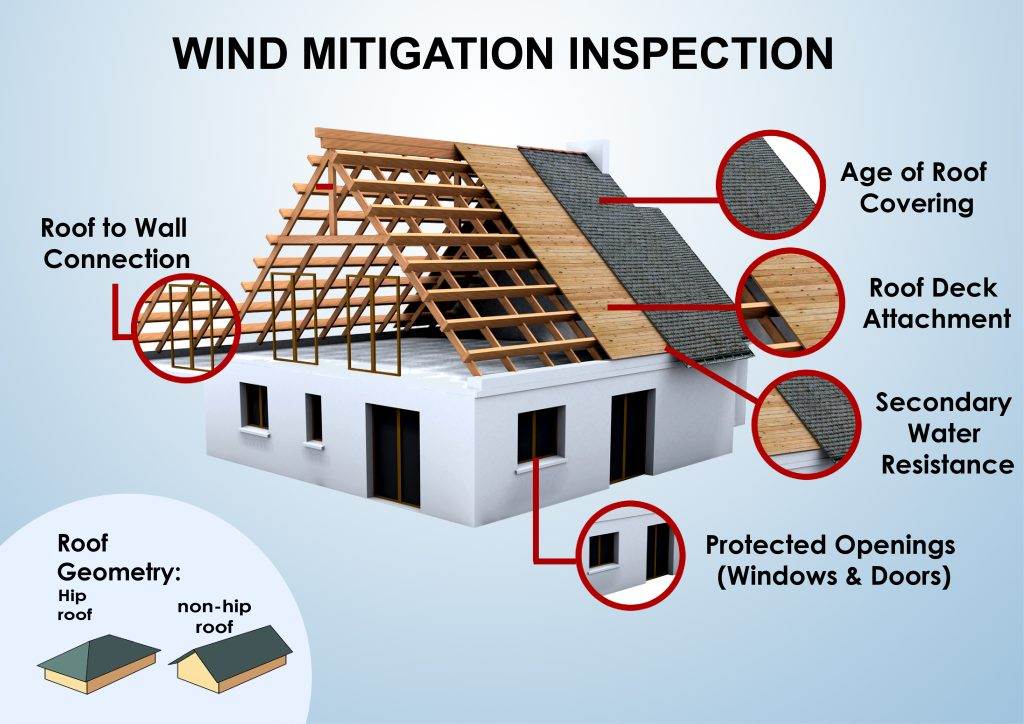
This image is property of dta0yqvfnusiq.cloudfront.net.
Frequently Asked Questions (FAQs)
What is a wind mitigation inspection?
A wind mitigation inspection is an assessment conducted by a certified inspector to evaluate a property’s resistance to wind and potential wind damage. The inspector examines various features of the property, such as the roof, external walls, opening protection, and attachment points, to determine its wind resistance capabilities. The purpose of the inspection is to identify and document wind mitigation measures in place, which may lead to potential savings on homeowners insurance premiums.
How long does a wind mitigation inspection take?
The duration of a wind mitigation inspection can vary depending on the size and complexity of the property. On average, a wind mitigation inspection takes between 60 to 90 minutes to complete. However, larger or more intricate properties may require additional time. It is advisable to consult with the inspector beforehand to get an estimate of the inspection duration for a specific property.
Can a wind mitigation inspection be performed on any type of property?
Yes, wind mitigation inspections can be performed on various types of properties, including single-family homes, townhouses, condominiums, and commercial buildings. The specific requirements for wind mitigation measures may vary depending on the property type, location, and local building codes. It is important to consult with a certified wind mitigation inspector to determine the appropriate assessment for a specific property.
Do I need a wind mitigation inspection if I have homeowners insurance?
While homeowners insurance typically covers wind damage, obtaining a wind mitigation inspection can potentially result in significant savings on insurance premiums. Wind mitigation inspections provide documented evidence of a property’s wind resistance features, allowing homeowners to negotiate lower rates with insurance companies. The inspection is not a requirement for obtaining homeowners insurance, but its associated cost savings and safety benefits make it a worthwhile investment.
What type of information is included in a wind mitigation report?
A wind mitigation report includes detailed information regarding a property’s wind resistance features. It typically includes an assessment of the roof’s construction and materials, exterior wall construction, opening protection, roof deck attachment, roof to wall connections, secondary water resistance, and other pertinent details. The report may also include recommendations for additional wind mitigation measures. Insurance companies use the information in the wind mitigation report to determine potential savings on homeowners insurance premiums.
Conclusion
Wind mitigation inspections are an important aspect of protecting properties in wind-prone areas. By considering factors such as the size and type of property, location, age, accessibility, and additional services requested, homeowners can estimate the cost of a wind mitigation inspection. The typical range of costs varies from low-end to mid-range and high-end, depending on various factors specific to each property. A comprehensive breakdown of the cost further reveals the components that contribute to the overall price.
When choosing a wind mitigation inspector, homeowners should prioritize certification, experience, reputation, insurance coverage, scheduling, and turnaround time for the report. By taking advantage of discounts, bundling services, and considering group inspections, homeowners can save on the cost of a wind mitigation inspection.
Understanding the importance of a wind mitigation inspection is essential, as it reduces insurance premiums, enhances home safety, strengthens resale value, and ensures compliance with insurance requirements. Comparing the cost of the inspection to the potential savings on insurance premiums helps homeowners evaluate the return on investment.
Finally, avoiding common mistakes in obtaining a wind mitigation inspection, such as hiring an unqualified inspector or neglecting necessary repairs, ensures the accuracy and reliability of the inspection process. Frequently asked questions provide additional clarity on the purpose and scope of a wind mitigation inspection.
In conclusion, a wind mitigation inspection is a valuable investment for homeowners in wind-prone areas. Its benefits extend beyond the initial inspection, ultimately leading to cost savings, enhanced safety measures, and increased property value. By understanding the factors, costs, and importance associated with wind mitigation inspections, homeowners can make informed decisions that protect their homes and promote overall peace of mind.
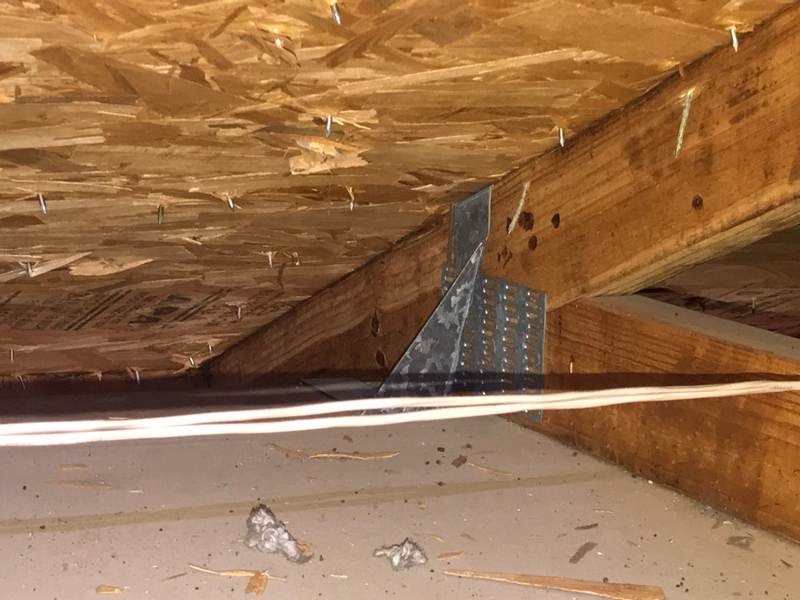
This image is property of boldcityhi.com.
